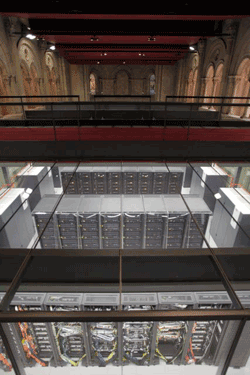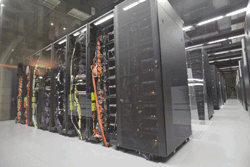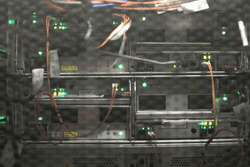Building tomorrow’s supercomputer
An IBM project in Barcelona
BY JENNIFER BALJKO
jbaljko@yahoo.com
Photos: Marc Herman
Supercomputing. Say the word, and images of gigantic 1960s-style mainframe systems will likely pop to mind. Given the computing power we carry around in our cell phones and laptops, they might even seem archaic to some segments of the population.
But that perception is far from reality. Nestled in many corners of the world, supercomputers are buzzing with activity as demand for sophisticated scientific research and complex simulations and calculations rapidly multiples.
In Europe, one such hub of computing ingenuity is MareNostrum, managed by a consortium among the Spanish Ministry of Education and Science, the Generalitat (the Catalan government), and the Technical University of Catalonia, known as Barcelona Supercomputer Center (BSC). MareNostrum stores, handles, and analyzes data through the simultaneous and parallel processing of 10,240 CPUs. It has peak performance of 94 TFLOPS, 372 Tbytes of storage capacity, and 20 Tbytes memory.

MareNostrum in a chapel: MareNostrum, a supercomputer in Barcelona, is housed in a former chapel located on the Technical University of Catalonia’s campus. Even so, it’s not enough power. This is where IBM comes in. IBM designed and built MareNostrum in 2004 (with IBM’s JS21 BladeCenter blade servers and dual-core I64-bit PowerPC 970MP processors), and has been collaborating with BSC on new-generation supercomputer attributes. Known as the MareIncognito project, the aim is to define the architecture and characteristics of supercomputers that could be operating at speeds in excess of 10 petaFLOPS.
Pere Albert, a senior IT architect at the IBM Innovation Initiative at BSC, gave Electronic Products a tour of MareNostrum and shared some details about how the MareIncognito research project is going.

MareNostrum inside: Although not the fastest supercomputer in the world, MareNostrum is one of the most powerful, with peak performance hitting 94 TFLOPS.
“The difficulties, uncertainties, risks, and challenges for such large systems are the current research for supercomputers,” Albert said. “There are several areas of interest in this research. [For example], we are doing joint research on processors. Generally, with processors, we are facing physical limitations of power, heat, and size, and we know we need to change things about the processors.”
Some of that research includes multicore processing, simplifying parallel programming, and load balancing, he noted.

MareNostrum at work: IBM and BSC are researching supercomputing challenges facing new-generation systems that will operate at 10 petaFLOPS and beyond.
“The ultimate goal is to have systems that produce results 100 or 1000 times faster. It’s not about running more FLOPS faster. It’s about producing the work faster,” Albert said.
Fundamentally, as well, supercomputers will continue to be based on commercially available components and platforms, making it easier to bring applications to the field, said Albert.
“If you take a look at the Top 500 [supercomputer] list, most of the current top 500 supercomputers use similar approaches and design principles that were applied when MareNostrum was designed. Almost all of them are clusters of nodes mostly using Linux operating system with commodity processors and a commercial interconnection network,” he said. As the PowerPC 970MP reaches end-of-life, supercomputers globally are being designed with IBM’s PowerXCell and Power7 processors, among others, Albert added.
While it sounds like pie-in-the-sky science fiction, the10-petaflop supercomputer is not as far away as it seems. IBM announced in February that the U.S. Department of Energy’s Argonne National Laboratory will use the company’s next-generation Blue Gene supercomputer to help design ultra-efficient electric car batteries, understand global climate change, and explore the evolution of the universe. “Mira,” as it’s called, will be twice as fast as today’s fastest supercomputer, and is expected to be operational in 2012. ■
Jennifer Baljko and Marc Herman are Barcelona-based print, Web, and multimedia journalists.
Advertisement
Learn more about Electronic Products Magazine





